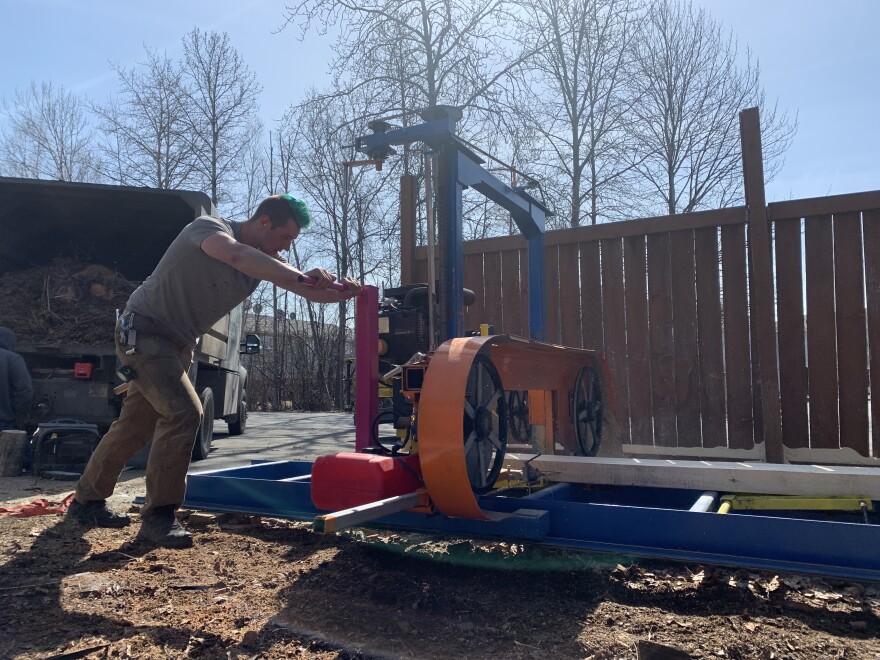The price of lumber has more than doubled over the last year and economists warn it may be a lasting trend. That’s why Alaskans like Hans Dow are getting crafty: Buying, or even building, their own sawmills.
“I was like, well, I want a sawmill. I can make a lot of stuff with it. I also need to learn how to weld,” said Dow, as he hefted a 9-foot log onto the deck of his hand-built sawmill, which sits in the corner of his South Anchorage backyard.
RELATED: Is Alaska’s pandemic housing market burning out or getting hotter?
Dow spent the winter in his garage building the sawmill. It was his brother who really urged him to take on the project, Dow said.
“He was working on his house and we were kind of joking like, ‘Man, lumber is really expensive. We could probably build a sawmill or buy a sawmill and make our own siding and probably break even or come out ahead.' And then I started to do the math. And I was like, ‘Oh yeah, it would be cheaper,'" he said.
The price of lumber is soaring for several reasons: When the coronavirus forced nationwide lockdowns, people stuck at home found projects to stay busy. Demand for lumber went up, but commercial sawmills were still locked down. Now, producers are scrambling to catch up. To top it off, record-low interest rates have driven lots of new home construction.
Dow spent about three weeks and $3,000 collecting the parts and pieces to assemble his mill. His aim was to build garden boxes for his wife this summer, and he estimated he'd need at least 42 2-by-10 inch boards to do it.
If he were to buy the lumber, it would cost him at least $2,000. But for Dow, spruce logs are free. He picks them up from Paul’s Tree Service, where he works as a crane operator. The company removes problem trees and beetle-infested spruce throughout the city.
Phil Hudson, 71, is a retired commercial radio host who's worked with wood for decades. Hudson lives on 40 acres in Willow, and when he built his house 20 years ago, he said it cost him $3,500. He said he’s been planning on more floor space for years.
“I'm adding a 16-by-24 addition,” Hudson explained. “And then there’s a couple other little bump outs off that. I'm about tripling my floor area."
If he purchased the lumber he needed to frame the addition walls last year, he might have paid more than $6 per board. This year, those same 2-by-6 inch boards cost at least $15. And depending on the type of wood and whether they've been pressure treated, the price can climb above $64.
“You can't pay these kind of prices,” he said. “It’s like going to the grocery store and spending two hundred dollars and leaving with one bag of groceries.”
Hudson traveled to Anchorage to pick up his brand new portable sawmill sent from Portland. With shipping and an extra box of blades, the mill set Hudson back around $10,000.
But Hudson has a plan to recoup the costs. Hudson has acres of standing deadwood on his property, thanks to spruce beetles which have affected more than 1.1 million acres of forest in Southcentral since 2015. After he cuts down the wildfire hazards and finishes his own building projects, he said he wants to use the mill to make some extra money.
“As this goes on, I'll make a few bucks in the future by building a kiln, and kiln-drying birch,” he said. “People like the birch and that live edge on the birch and that sort of thing.”
He can mill that, he said.
“What the hell — I don't know how many years I have left, so I might as well do something that's entertaining," he said.
Hudson purchased his mill from Wood-Mizer, an Indiana-based company that manufactures tools for processing lumber, including small, portable sawmills. The company’s cheapest mill is just over $3,000, and prices rise to nearly $60,000. To say they're selling fast is an understatement.
“The lead time is 44 to 59 weeks right now for a sawmill,” said Kate Sebring, an Alaska-based sales representative for Wood-Mizer. Other sawmill manufacturers are telling customers the same thing, she said.
Sebring quit her job at JBER last year to work with her father, Parker Rittgers, who originally became a sales rep for Wood-Mizer as a retirement hobby.
“I've been retired for ten years, so now I'm not working 40 hours a week,” Rittgers joked. “I'm working 50 or 60 hours. I worked until about 10:30 p.m. last night. I was just bushed.”
A year and half ago, Rittgers said he was taking orders for one sawmill a week. Now, he and his daughter take deposits for three or four sawmills a day.
In Alaska, business doesn’t just come from the road system. Don Morgan was also at the Wood-Mizer office last month, shopping for a sawmill. He took the two hour flight from Aniak, a village of about 500 people in Southwest Alaska, to put his order in.
“I'm changing my shop into a house, so now I need a shop,” he said.
If he were to order the lumber he needs for his project, just shipping the boards to the village would cost at least $2,000. Nevertheless, he balked a little at the $10,000 price tag for the mill he came to consider.
“But I don't know … We had a lot of trouble with building houses and getting material,” he said.
Aniak sits east of Bethel on the Kuskokwim River, where there are plenty of trees. Morgan can tow his mill with a snowmachine or a four-wheeler and find the wood he needs.
According to Kate Sebring, Wood-Mizer has shipped dozens of sawmills to villages across the state. Even with the shipping costs of the mill, many Alaskans are convinced milling their own lumber is more affordable than buying it.



